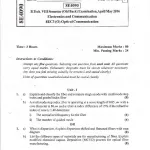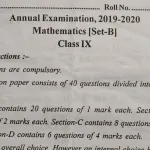Preparing for the Aligarh Muslim University (AMU) Class 11 Science entrance exam requires a thorough understanding of various subjects, including Physics, Chemistry, Biology, and Mathematics. Below are sample questions and answers from previous years’ papers to aid in your preparation.
Physics
-
Question: What is Newton’s Second Law of Motion?
Answer: Newton’s Second Law states that the force acting on an object is equal to the mass of that object multiplied by its acceleration (F = ma).
-
Question: Define kinetic energy.
Answer: Kinetic energy is the energy possessed by an object due to its motion, calculated as KE=12mv2KE = \frac{1}{2}mv^2, where mm is mass and vv is velocity.
-
Question: What is the principle of conservation of momentum?
Answer: The principle states that the total momentum of a closed system remains constant if no external forces act on it.
-
Question: Explain the difference between scalar and vector quantities.
Answer: Scalar quantities have only magnitude (e.g., mass, temperature), while vector quantities have both magnitude and direction (e.g., velocity, force).
-
Question: What is Ohm’s Law?
Answer: Ohm’s Law states that the current through a conductor between two points is directly proportional to the voltage across the two points, provided the temperature remains constant (V = IR).
-
Question: Define acceleration due to gravity.
Answer: It is the acceleration experienced by an object due to Earth’s gravitational pull, approximately 9.8 m/s29.8 \, \text{m/s}^2 near the Earth’s surface.
-
Question: What is the unit of power?
Answer: The SI unit of power is the watt (W), where 1 W=1 joule/second1 \, \text{W} = 1 \, \text{joule/second}.
-
Question: Explain the term ‘work’ in physics.
Answer: Work is done when a force applied to an object causes displacement in the direction of the force, calculated as W=F×d×cosθW = F \times d \times \cos\theta.
-
Question: What is meant by the term ‘inertia’?
Answer: Inertia is the property of an object to resist changes in its state of motion or rest.
-
Question: Define frequency in the context of wave motion.
Answer: Frequency is the number of complete oscillations or cycles per unit time, measured in hertz (Hz).
Chemistry
-
Question: What is the atomic number?
Answer: The atomic number is the number of protons in the nucleus of an atom, which determines the element’s identity.
-
Question: Define molarity.
Answer: Molarity is the concentration of a solution expressed as the number of moles of solute per liter of solution (mol/L).
-
Question: What is the pH scale?
Answer: The pH scale measures the acidity or alkalinity of a solution, ranging from 0 (most acidic) to 14 (most basic), with 7 being neutral.
-
Question: Explain the law of conservation of mass.
Answer: This law states that mass is neither created nor destroyed in a chemical reaction; the total mass of reactants equals the total mass of products.
-
Question: What are isotopes?
Answer: Isotopes are atoms of the same element with the same number of protons but different numbers of neutrons, resulting in different atomic masses.
-
Question: Define electrolysis.
Answer: Electrolysis is the process of using electrical energy to drive a non-spontaneous chemical reaction, typically the decomposition of compounds.
-
Question: What is a covalent bond?
Answer: A covalent bond is a chemical bond formed by the sharing of electron pairs between atoms.
-
Question: Explain the term ‘oxidation’.
Answer: Oxidation is the loss of electrons by a molecule, atom, or ion, often associated with the gain of oxygen or loss of hydrogen.
-
Question: What is an acid according to the Arrhenius definition?
Answer: An Arrhenius acid is a substance that increases the concentration of hydrogen ions (H⁺) in aqueous solution.
-
Question: Define the term ‘catalyst’.
Answer: A catalyst is a substance that increases the rate of a chemical reaction without undergoing permanent chemical change.
Biology
-
Question: What is the basic unit of life?
Answer: The cell is the basic structural and functional unit of all living organisms.
-
Question: Define photosynthesis.
Answer: Photosynthesis is the process by which green plants use sunlight to synthesize nutrients from carbon dioxide and water, producing oxygen as a byproduct.
-
Question: What is DNA?
Answer: DNA (deoxyribonucleic acid)
Recommended Indian Books for AMU Class 11 Science Previous Year Papers and Practice
-
AMU Class 11 Entrance Exam Guide – Arihant Experts (Arihant Publications)
Contains chapter-wise previous year questions with detailed solutions in Physics, Chemistry, Biology, and Mathematics. Also includes mock tests and model papers aligned with AMU’s pattern. -
AMU Class 11 Science Entrance Practice Papers – Dr. Lal & Jain (Upkar Prakashan)
Offers solved practice papers, sample sets, and conceptual theory based on past trends. Questions are generally moderate-level and objective in nature. -
Target AMU Class 11 Entrance – R. Gupta (Ramesh Publishing House)
Covers previous years’ solved papers, short theory for all subjects, and a set of unsolved mock tests. Questions include factual, reasoning-based, and diagram-related problems. -
AMU Guide for Class XI Science – Shamsher Ali (Shining Star Publications)
Focuses on key concepts with simplified explanations followed by multiple choice and descriptive questions. Includes commonly asked question patterns and revision notes. -
Self Study Guide for AMU Science Stream Class 11 – Arihant Experts (Arihant Publications)
Includes a mix of conceptual, numerical, and theoretical questions. Also provides tips for time management and question solving strategies specific to AMU format. -
Comprehensive AMU Class XI Science Entrance Book – S.K. Ojha (Pragati Prakashan)
The book combines syllabus-based theory with previously asked questions and new model questions. Emphasis is given to conceptual clarity with flow charts and illustrations. -
AMU Science Stream Class 11 Practice Workbook – J.K. Yadav (Youth Competition Times)
Contains high-yield topic-wise question banks, updated sample papers, and practice MCQs for all subjects with answer explanations. -
Mastering AMU Class 11 Entrance Exam – V. Verma (GKP Publications)
Focused on entrance-level problem-solving techniques. Includes both subject-wise MCQs and mixed mock tests that simulate actual exam difficulty. -
AMU XI Science Entrance Solved Papers – Editorial Board (Oswaal Books)
Offers year-wise question papers with detailed solutions and analysis. Questions are categorized as memory-based, concept-based, and application-based. -
AMU Entrance Preparatory Series: Class XI Science – K.N. Sharma (Pinnacle Books)
This book includes logical sequencing of past questions, with key concept notes, short tricks, and subject-wise preparation plans. It has a strong focus on Physics and Chemistry numericals. -
Smart Practice Papers for AMU Class 11 – Deepika Rani (Trueman’s)
Contains time-bound practice sets and scoring strategy guidance. Questions range from factual recall to interpretative diagrams and process-based biology questions. -
AMU XI Science Model Paper Set – Dr. R.K. Jha (Sahitya Bhawan Publications)
Offers full-length model test papers as per recent exam format. Each set is followed by solutions and performance analysis. -
Success Mirror for AMU Class 11 Science – P. Singh (Kiran Institute)
Blends topic theory, formula sheets, previous year MCQs and quick revision capsules. Content is ideal for last-month preparation. -
Objective AMU Science Class XI – N. Ahmed (New Light Publishers)
A comprehensive book full of topic-wise MCQs and previous AMU question patterns. Focused mainly on Physics and Chemistry. -
Excellence Guide for AMU XI Entrance Science – R. Akhtar (Navneet Publications)
Includes brief theory and mixed-format questions (MCQs, assertion-reason, match the column) along with detailed explanations. -
AMU Class XI Entrance Science Pathfinder – Prof. Hameed Ali (Pathfinder Education)
Targets weak areas with diagnostic tests, enriched theory sections, and frequently repeated questions from previous exams. -
Complete Entrance Preparation for AMU Class XI Science – P. Ali (Vidya Publications)
Blends subject summaries with topic-based short tests, common traps, and past questions. Great for daily practice and revisions. -
All-in-One AMU Class 11 Science Entrance Book – Vikas Tyagi (Golden Guide Series)
Offers all subjects under one cover with short notes, tips, and full-length tests. Focuses on scoring topics and conceptual clarity. -
Rapid Revision & Practice for AMU XI Science – Javed Khan (Sunrise Publishers)
Designed for quick brush-up before exams. Includes rapid review points, typical objective questions and concise solutions. -
Scientific Approach to AMU Class 11 Entrance – Sanjay Kumar (Disha Publications)
Known for its subject-wise segregation and strategy-based problem solving. Covers analysis of frequently asked concepts and common errors.
AMU Last Year Question Paper of Class 11 Science: A Must-Have Tool for Smart Preparation
When preparing for the Aligarh Muslim University (AMU) Class 11 Science entrance exam, having access to last year’s question papers can make a significant difference. These papers are not just sets of questions — they are strategic tools that help you understand the real exam pattern, manage time effectively, and sharpen your problem-solving skills.
The AMU entrance exam for Class 11 Science is known for its conceptual depth and subject-wide coverage. It includes Physics, Chemistry, Biology, and Mathematics. Each subject requires a different approach, and the last year’s papers help you identify those nuances. Solving them is like stepping into the shoes of a past candidate — you learn what to expect, what to prioritize, and how to pace yourself.
A well-structured study plan starts with understanding the question trends. AMU tends to repeat core concepts and commonly tested topics across the years. Analyzing previous papers allows students to pick up on these patterns. For example, in Physics, you might notice recurring emphasis on laws of motion and electricity. In Chemistry, questions often revolve around atomic structure, periodic classification, and chemical reactions. Biology tends to focus on cell structure, plant physiology, and human anatomy. Meanwhile, Mathematics often tests concepts like algebra, coordinate geometry, and trigonometry.
Another advantage of working through last year’s papers is improving speed and accuracy. Since the entrance exam is time-bound, students must not only know the answers but also be able to apply their knowledge quickly. Practice with real questions under timed conditions helps reduce anxiety and boosts confidence.
Experts also recommend using these papers for self-assessment. After attempting a paper, reviewing the answers and understanding mistakes is essential. It gives students a clear direction on where they stand and which areas need more attention.
To get the most out of AMU Class 11 Science question papers, create a revision schedule that includes regular mock tests using past papers. Divide your time wisely among subjects and analyze which types of questions you struggle with most. Focus more on those weak areas in your study sessions.
It’s also a good idea to practice papers from at least the last five years. This ensures broader coverage of the syllabus and better familiarity with question formats. Remember, the goal is not to memorize the questions, but to understand how AMU frames problems and what kinds of answers they expect.
Using these papers alongside your textbooks and reference guides makes your preparation more complete. It gives your study process real direction and helps simulate the actual test environment.
FAQ for amu last year question paper of class 11 science
What subjects are covered in the AMU Class 11 Science entrance paper?
The exam includes Physics, Chemistry, Biology, and Mathematics. All subjects are typically objective-type and concept-based.
How can I get access to last year’s AMU Class 11 Science question papers?
These are often included in entrance prep books and available in various offline and online formats. Look for books with solved papers.
Are the questions repeated from previous years?
While exact questions may not repeat, the same concepts and topics are often tested in similar formats across years.
How many years of previous papers should I solve?
Solving the past five years’ papers is ideal. It gives a broad idea of trends and helps reinforce important topics.
Is solving question papers enough for AMU entrance exam preparation?
Not entirely. Use question papers as a tool to complement your study materials and test your knowledge regularly.
What is the level of difficulty in the AMU Class 11 Science paper?
The paper ranges from moderate to slightly challenging, with a focus on concept clarity and problem-solving.
Should I take mock tests based on last year’s papers?
Yes, mock tests using actual papers help improve time management and reduce exam-day stress.
How long should I take to solve one past paper?
Try to solve it within the actual exam time limit, usually around 2 hours, to build time efficiency.
Are solutions provided with last year’s question papers?
Many books and practice sets offer detailed explanations, which help in learning the logic behind each answer.
Can I prepare for all subjects equally using last year’s papers?
Yes, but you should focus more on your weaker subjects while maintaining regular practice in stronger areas too.
Latest Posts
- Step-by-step guide to download and apply for jee mains admit card 202
- Comprehensive 2025 government holidays and recruitment details for job seekers
- JEE Mains Admit Card 2025: Your Step-by-Step Guide to Downloading the Hall Ticket
- Everything You Need to Know About 2025 Government Holidays Recruitment
- Comprehensive Guide to rrb d group recruitment 2025 – Eligibility, Vacancies, and Application
- Detailed guide to nps trust recruitment 2025 vacancies, eligibility and apply process
- Comprehensive guide to hpcl recruitment 2025 notification, vacancies, and application process
- ignou bed admission 2025 complete recruitment guide with eligibility and process
- Comprehensive Guide to Indian Army Agniveer Recruitment 2025 Notification and Jobs
- Everything You Must Know About CBSE Board Exams 2025 Changes & New Rules




